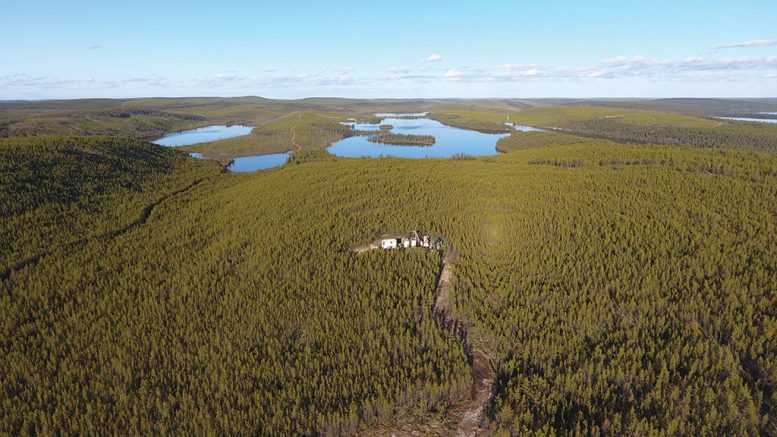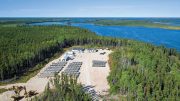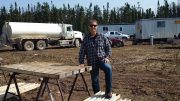UEX (TSX: UEX) has intersected new uranium mineralization at its 60%-owned Christie Lake project, 9 km northeast of Cameco’s (TSX: CCO; NYSE: CCJ) McArthur River uranium mine in northern Saskatchewan.
The new mineralization was found in hole 141, 8 metres above an unconformity. The drill hole returned a radiometric equivalent grade (REG) of 1.17% uranium oxide (U₃O₈) over 2 metres, from 498 metres.
Due to the poor recovery within the mineralized interval in 141, the company says, REGs are considered more accurate than assay grades. Using down-hole probes to calculate REGs is commonly done in the Athabasca basin to measure uranium concentration in-situ within a drill hole, UEX says.
“This is the first, over 1% grade intersection found outside the footprint of the existing deposits on a parallel structure called the B trend,” says UEX president and CEO Roger Lemaitre. “I wouldn’t say we are at the discovery stage yet, but it is very, very encouraging.”

The camp at UEX’s Christie Lake property. Credit: UEX.
Hole 141 was drilled to test the B trend that lies 600 metres along strike northeast of the historical drill hole 48, which averaged 0.25% U₃O₈, 2.05% cobalt and 2.32% nickel over 2 metres, within a fault structure located 50 metres below the unconformity.
Strong hydrothermal alteration was also observed in drill holes collared northeast of 141 and 1.5 km southwest in hole 147, drilled at the southernmost end of the B trend that coincides with another low-resistivity anomaly.
In the Orora North area, three holes were drilled to test the southwest margin of the large and strong resistivity anomaly found at the unconformity north of the Orora deposit and parallel to the Yalowega trend, a 4.2 km corridor with anomalous uranium and indicative hydrothermal alteration that hosts three high-grade uranium deposits. Strong hydrothermal alteration, including thick dravite, clay-filled veins, was found in holes 142, 143 and 145 along a northwest-oriented fault structure.
The project hosts the Paul Bay, Ken Pen and Orora uranium deposits, which have a total inferred resource of 588,000 tonnes with an average grade of 1.57% U₃O₈ for 20.35 million contained lb. U₃O₈. The three deposits remain open at depth and along strike.
“Christie is our most advanced project,” Lemaitre says. “We are still trying to grow those resources to be economically viable.”
Lemaitre says the company has looked outside the three deposits to find mineralization in the second phase of its 2019 exploration drilling program, which comprised 8,122 metres of diamond drilling in 14 holes. Diamond drilling focused on three areas: an anomaly at the B trend over known mineralization, the Orora North offset, and the Southwest C extension.
The Paul Bay zone is an 80-metre-long mineralized body that plunges 200 metres southwest from the unconformity and follows the dip of faulted lower Wollaston domain graphitic metasedimentary rocks.
The Ken Pen zone is 260 metres northeast of the Paul Bay zone, striking northeast concordant with the Yalowega trend fault.
The Orora zone, which UEX discovered in 2017, is 360 metres northeast of the Ken Pen zone.
UEX will propose plans for more drilling and geophysical surveying at the Orora North and the B trend area in the first half of 2020 for consideration by its joint-venture partner, JCU Canada. JCU is a private company owned one-third by Itochu Corp., one-third by Mitsubishi Corp. and one-third by Overseas Uranium Resources Development.
In terms of Saskatchewan as a mining jurisdiction, Lemaitre notes that the province offers a friendly environment for exploration and mining. “Because they have a long history of uranium mining in the Athabasca basin, the communities nearby are generally very supportive of what we do.”
There is also readily available skilled labour. “People are familiar with the basin and how to drill there, so it is more cost effective than it would be in some other places,” Lemaitre says. “We are probably in a jurisdiction where the market has a bigger impact on investment decisions than the political process.”
The Christie Lake project — which encompasses most of Yalowega Lake and measures 79.2 sq. km comprising six contiguous areas — is located within the Athabasca sedimentary basin region, coincident with the Athabasca Plain ecoregion and Boreal Shield ecozone. The topography of the area is relatively flat, characterized by glacial moraine, outwash, drumlins and lacustrine plains.
The Christie Lake project first consisted of three claims staked between 1985 and 1986 by PNC Exploration, a mineral company based in Tokyo, Japan. Three more claims were staked and added to the project in 1990. PNC owned and operated the project from 1985 to 2000, and the six claims were actively explored until 1997.
In November 2000, JCU acquired 100% ownership of the project. Exploration activities remained dormant until January 2016, when JCU entered into an option agreement with UEX. The agreement allowed UEX to earn up to 70% of the project over four years. The option agreement ended in November 2018, and the companies entered into a joint-venture agreement under which UEX and JCU hold 60% and 40% interests in the project.
Lemaitre says the company’s interest in Christie Lake will increase to 64% because JCU is lowering the amount of money it will spend on this year’s exploration program.
UEX has three other flagship projects: Horseshoe–Raven, 5 km south of Cameco’s Rabbit Lake operation; Shea Creek, 18 km south of the past-producing Cluff Lake mine; and the West Bear cobalt-nickel project, 740 km north of Saskatoon.
The company traded at 13¢ within a 52-week range of 13¢ to 21.5¢ per share at press time. It has 381 million common shares outstanding for a $49.5-million market capitalization.





Be the first to comment on "UEX finds mineralization at Christie Lake"